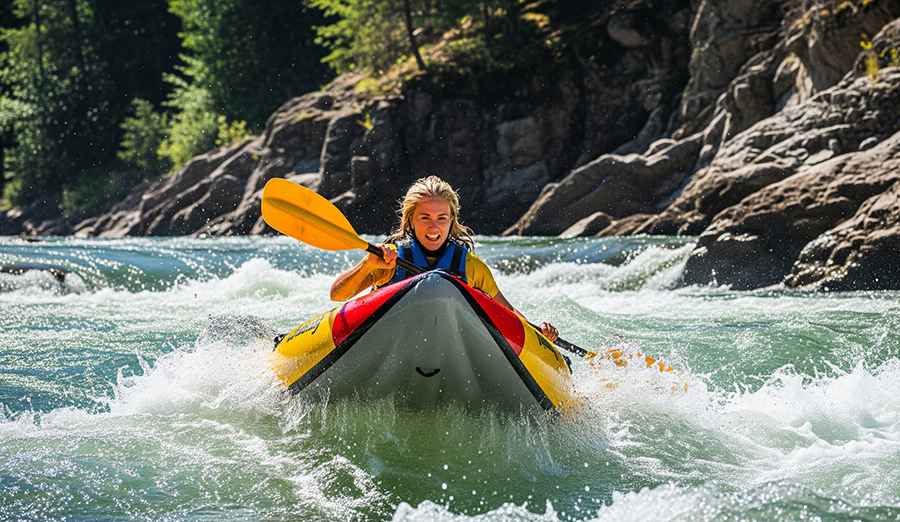Paddling the World's Most Perilous Waters: Inflatable Kayaks on Dangerous River Routes
Inflatable kayaks have evolved far beyond recreational use. Once reserved for tranquil lakes and gentle rivers, they are now part of expeditions through some of the world’s most unpredictable and hazardous waterways. With rugged designs, reinforced materials, and improved hydrodynamics, these vessels are proving their worth in regions where traditional kayaks are either impractical or impossible to carry.

In rugged terrain, portability often determines access. Expedition paddlers facing remote or high-altitude routes increasingly turn to the inflatable kayak as a lightweight yet capable alternative. Despite weighing under 15 kilograms, high-performance models offer robust protection against sharp rocks, icy water, and Class IV rapids. The key lies in selecting a model built specifically for dangerous, fast-moving waters.
Built to Withstand the Unforgiving
Advanced Construction for Demanding Conditions
Durability is paramount on treacherous rivers. Top-tier inflatable kayaks feature military-grade PVC, multi-layer drop-stitch floors, and reinforced seams designed to handle impact from boulders, submerged logs, and gravel landings. For example, kayaks built for whitewater often support pressures up to 12 PSI, creating a near-rigid platform that remains stable in turbulent flows.
Several models, such as the Aire Lynx or the NRS Outlaw, include self-bailing floors that quickly drain incoming water, a vital feature in churning rapids. Additional elements like adjustable thigh straps, abrasion-resistant hulls, and high-capacity valves allow paddlers to maintain control in unpredictable currents. These features mirror those found in expedition-grade hardshell kayaks, but with the added benefit of foldability.
Packability for Remote River Access
Expedition paddlers frequently face logistical hurdles. Reaching remote river entries, such as those found in Mongolia’s Khovd River basin or Peru’s Río Marañón, often involves long hikes or air travel. Inflatable kayaks collapse into compact packs, allowing adventurers to bypass inaccessible zones and carry their gear deep into uncharted territory.
Some paddlers even combine inflatable kayaks with bikepacking or alpine climbing gear to approach isolated headwaters. In these scenarios, a full-sized composite kayak would be impossible to transport. The inflatable alternative opens doors to technical descents that would otherwise remain out of reach.
Global Rivers Where Inflatable Kayaks Prove Themselves
Zambezi River, Zambia
One of the most infamous Class V whitewater rivers, the Zambezi near Victoria Falls challenges even experienced paddlers. With steep drops, massive standing waves, and unpredictable hydraulics, it demands agile equipment. Inflatable kayaks rated for whitewater provide flexibility through tight canyons and rapid exits on rough terrain.
Sixmile Creek, Alaska
Fed by glacial meltwater, this Alaskan route offers freezing temperatures, narrow rock-lined chutes, and continuous gradient drops. Self-bailing inflatables with cold-resistant coatings perform well under such punishing conditions. Safety becomes a top priority in these waters, and reliable gear often determines the success of a descent.
Jalcomulco, Mexico
The Río Pescados in Veracruz (Mexico) offers a mix of Class III and IV rapids through dense tropical forest. During rainy season surges, water levels can change rapidly. Inflatable kayaks excel in these changing conditions due to their forgiving hull shape and ability to absorb impact, reducing injury risk during accidental flips or collisions.
Quality, Transparency, and Sustainability in Extreme Gear
Manufacturing with Responsibility
Adventurers tackling remote and protected waterways often emphasize sustainability. Ethical gear choices help reduce environmental impact. High-end inflatable kayak manufacturers now disclose detailed information about sourcing, production methods, and emissions control. Brands such as Kokopelli and Aquaglide publish environmental impact reports and utilize recycled components wherever feasible.
This transparency fosters informed decisions among paddlers who care about both performance and planetary responsibility. Repair kits, modular components, and recyclable packaging reflect a growing trend toward durable, repairable products designed for long-term use, not seasonal disposal.
Balancing Risk with Design Integrity
Quality control and safety certifications matter more when navigating high-consequence environments. International safety standards, including ISO 6185 and CE certification, provide assurance of tested buoyancy, valve reliability, and inflation integrity. These technical standards separate expedition-grade kayaks from their recreational counterparts.
Additionally, companies are becoming more transparent with performance testing. Whitewater-rated models often include max load data, inflation tolerance charts, and video demonstrations of extreme testing scenarios. This openness supports buyers in choosing models that genuinely match their skill level and the risk profile of their chosen river.
A New Era of Expedition Possibilities
Inflatable kayaks are no longer niche tools for casual paddlers. In the right hands, and with the right design, they enable expeditions on rivers once considered inaccessible without costly logistics or local rentals. From high-alpine glacial outflows to equatorial torrents, these kayaks transform how explorers interact with some of the most dangerous rivers on Earth.
They combine safety, portability, and performance into a single platform that respects both the environment and the adventure. For thrill-seekers venturing beyond well-mapped waters, an inflatable kayak is not a compromise—it is a calculated, tactical advantage built for survival, speed, and exploration.